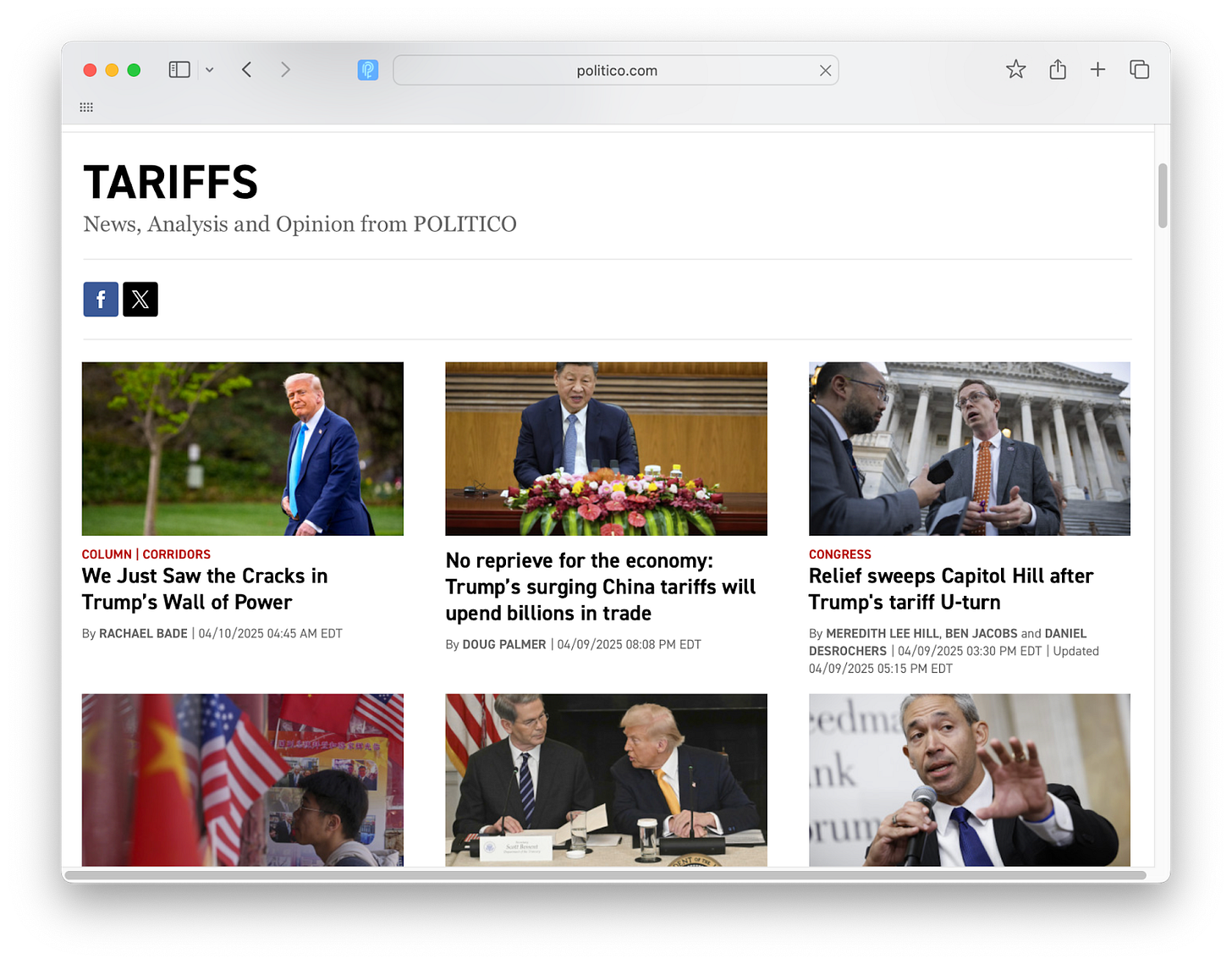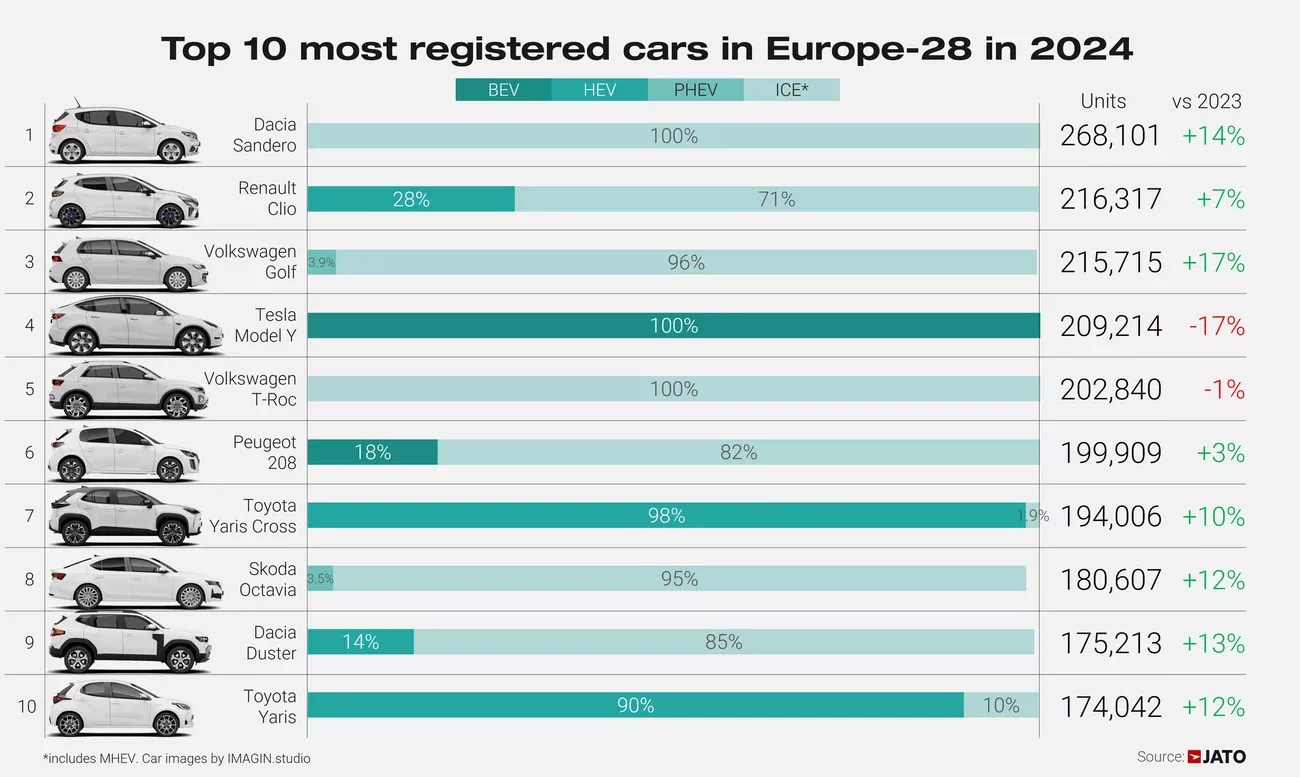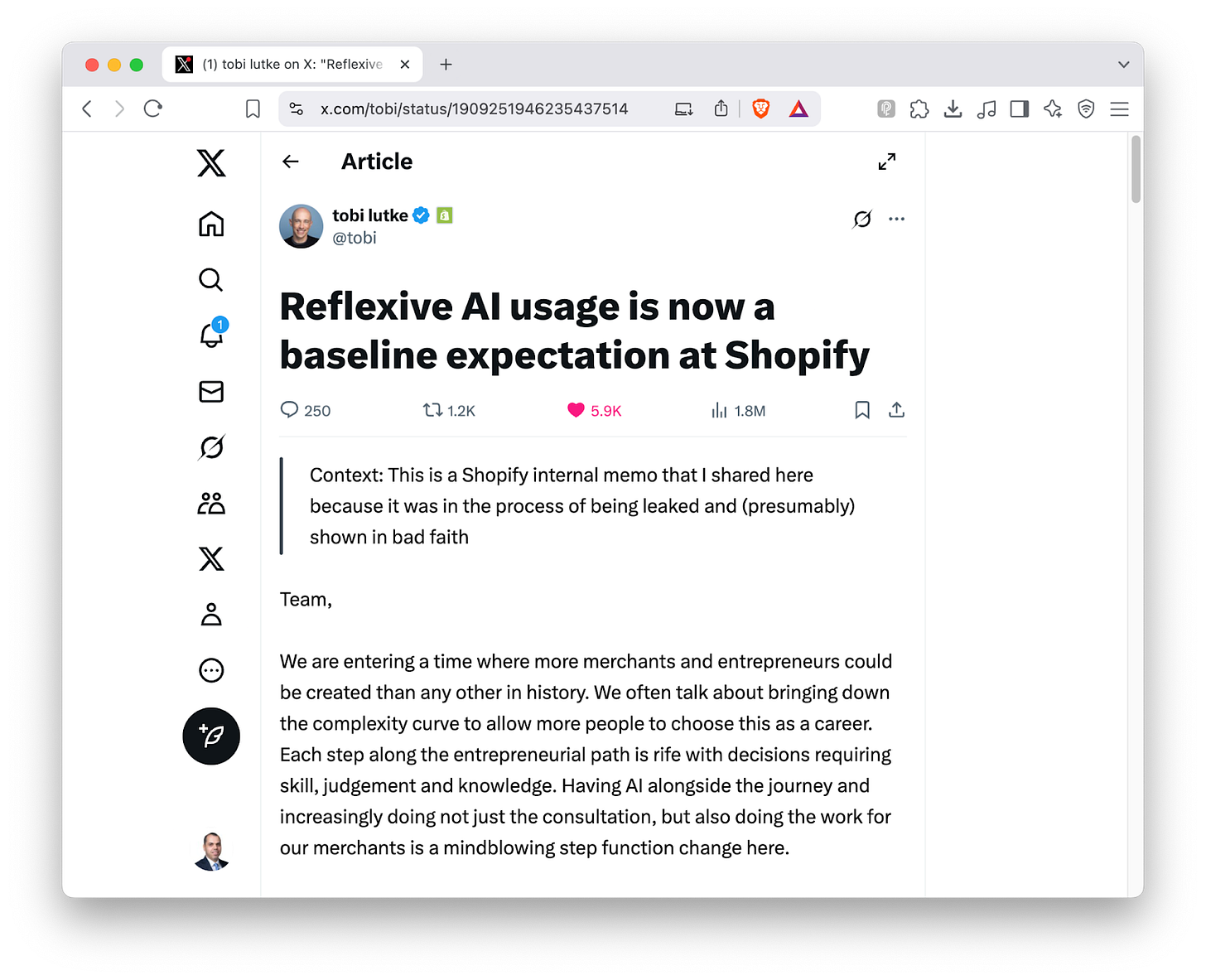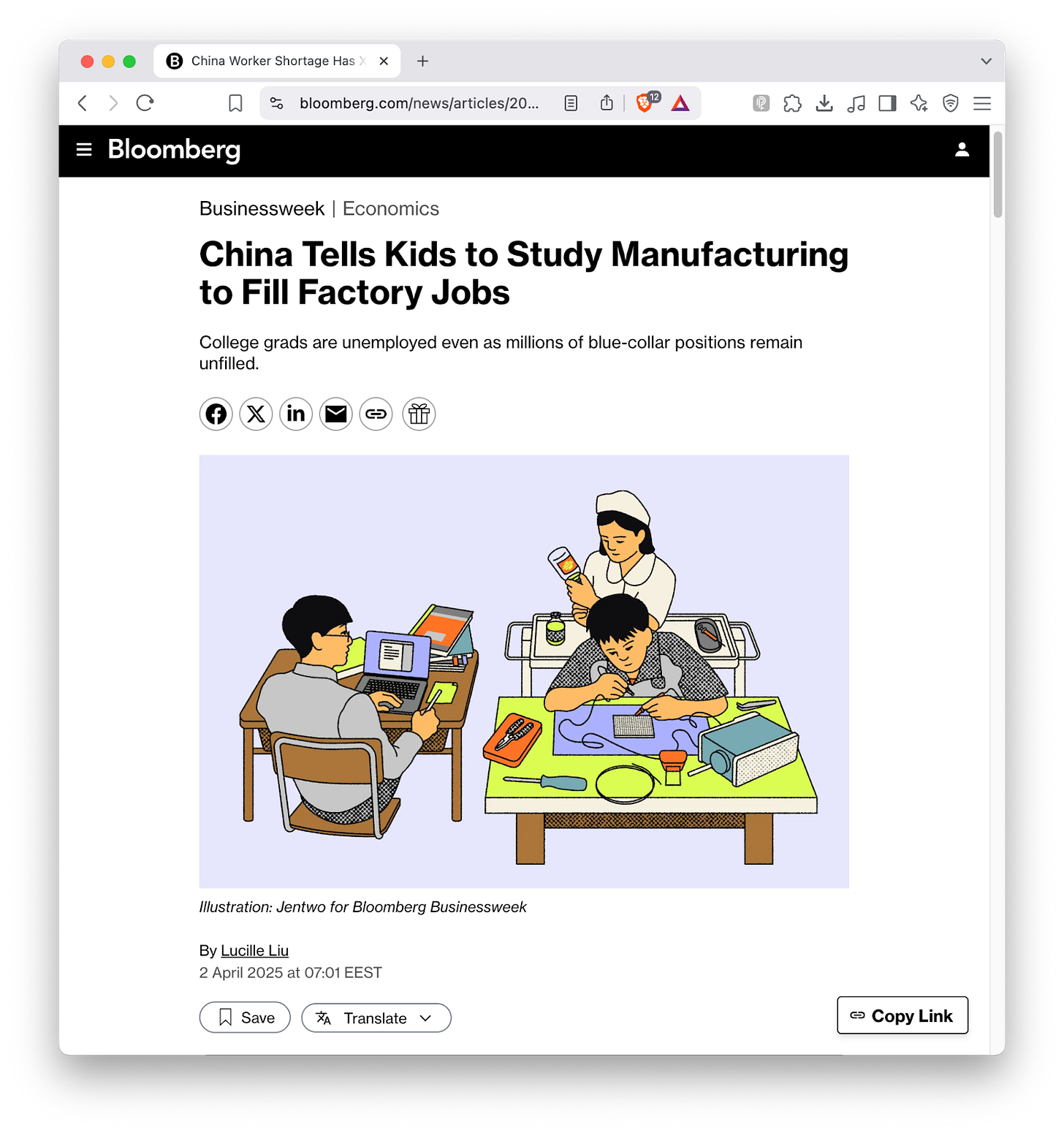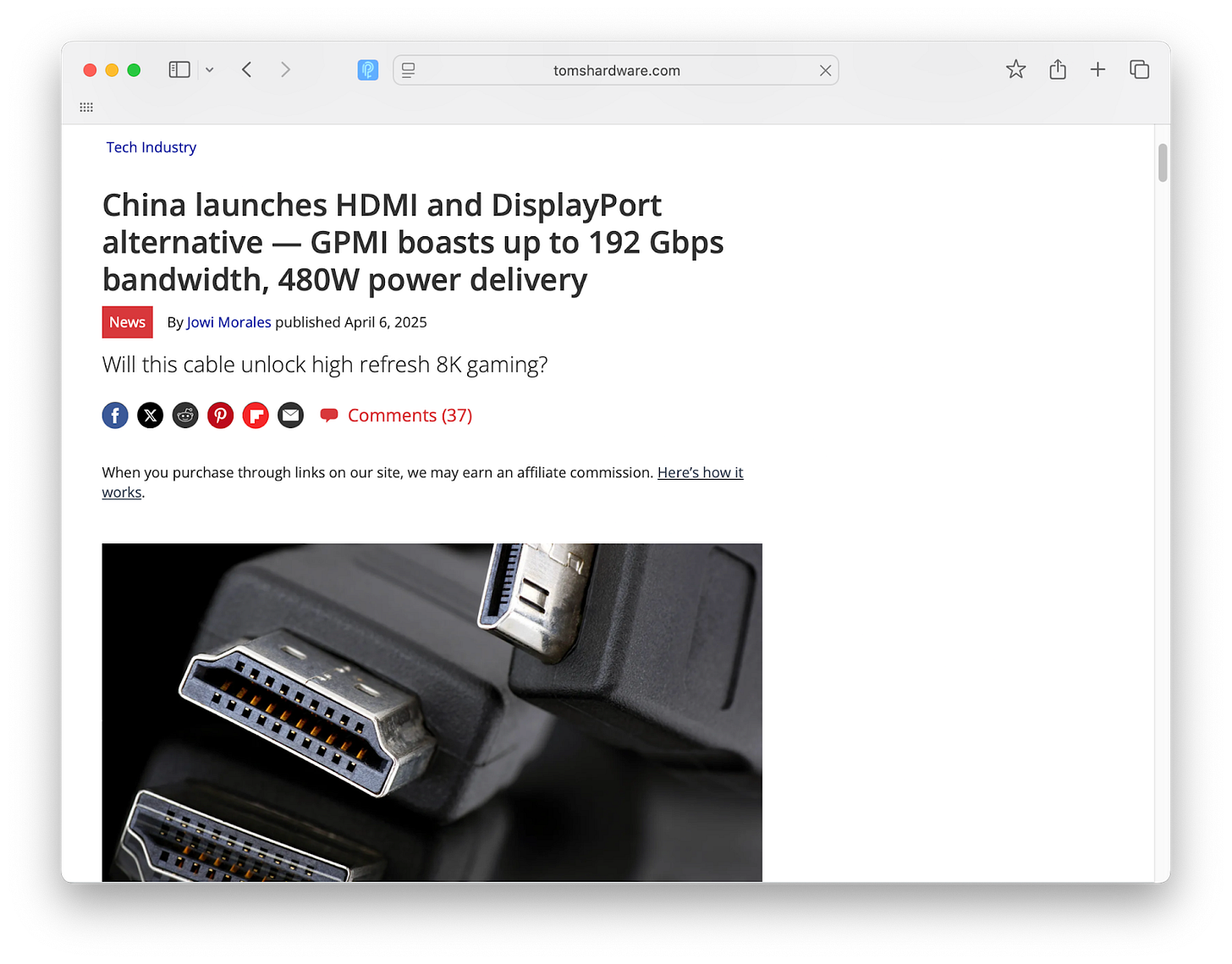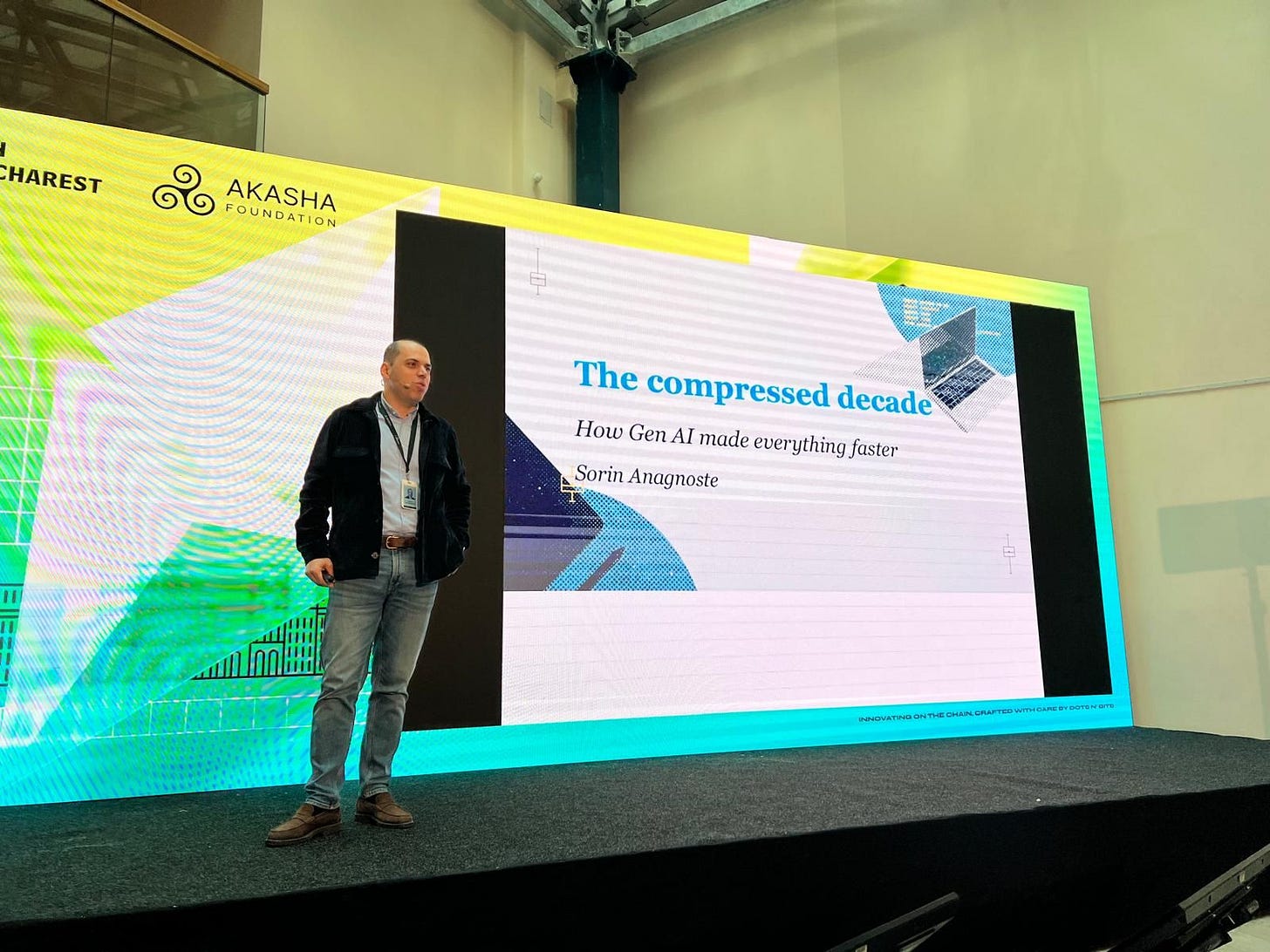(#121) Tarrifs: A new American order; Less 🇺🇸 Tesla, more 🇷🇴 Sandero
Shopify: AI in all and for everyone
Dear #onStrategy reader,
Here is what you’ll find in this edition:
🇺🇸 Tarrifs: A new American order
Europe drives into the slow lane: less 🇺🇸 Tesla, more 🇷🇴 Sandero
Shopify: AI in all and for everyone
Bloomberg: “China Tells Kids to Study Manufacturing to Fill Factory Jobs”
🇪🇺 EU’s Type-C: Setting the standard, missing the connection
🖥️ "The Compressed Decade: How Gen AI made everything faster"
Onto the update:
🇺🇸 Tarrifs: A new American order
What a chaotic 7 days we have had. Tariffs are bad, but here are three insights:
1/ Tariffs signal deeper systemic breakdowns
Ray Dalio argues that today’s tariffs are symptoms of profound global shifts in monetary, political, and geopolitical orders. Tariffs reflect imbalances. Countries like the USA have grown dependent on debt-driven consumption, while countries like China depend on exports to sustain their economies. These dynamics aren’t sustainable, making tariffs a predictable but superficial response to deeper issues: a global system nearing a breaking point. LINK
2/ Tariffs disrupt technological innovation and military capability
Ben Thompson emphasizes that indiscriminate tariffs, like those the Trump administration imposed, undermine precisely the industries they’re meant to protect. Blanket tariffs hurt domestic industries dependent on global supply chains, especially high-tech manufacturing critical to national security. Thompson highlights that tariffs, intended to revive American manufacturing, ironically threaten the country’s capacity to maintain technological leadership, weakening its strategic autonomy. LINK
3/ The USA is using tariffs to map vulnerabilities and understand strategic dependencies.
Beyond immediate economic impacts, tariffs help expose the real points of dependency, especially in technology and military sectors. By imposing tariffs, the USA forces the identification of vulnerabilities within its supply chains, revealing where strategic autonomy is compromised. This is crucial for national security, helping policymakers discern between mere economic inconvenience and genuine strategic risk. However, this benefit comes at a high price: it risks damaging industries before the USA can even rebuild its domestic capabilities. LINK
Europe drives into the slow lane: less 🇺🇸 Tesla, more 🇷🇴 Sandero
1/ First of all, congratulations to the Dacia Sandero for becoming Europe’s best-selling car in 2024, beating the Tesla Model Y. The Sandero is Europe’s new automotive superstar, not because it does zero-to-sixty particularly fast (or even, really, particularly noticeably), but because it does zero-to-ownership-cheaply. A Sandero starts around EUR 13,000, compared to a Model Y that’s priced comfortably into the range of “I’m sorry, did you say euros or kidneys?”. So, Europeans are voting decisively for the cheaper option. Which, sure, you might say is just smart consumer behavior, but maybe it also reflects the uncomfortable reality that Europe, collectively, is feeling a bit poorer these days.
2/ Second, it’s tempting to think the Sandero victory is about practicality or a collective distaste for Elon Musk tweeting controversial things. But maybe, just maybe, it’s simpler: European consumers are opting for austerity on four wheels. European car buyers aren’t necessarily “preferring” the Sandero’s minimalist charm. They’re settling for it because the premium alternative (the Tesla) increasingly feels like a luxury many can’t justify. When your economy is stuck somewhere between stagnation and mild panic, splurging on a Tesla might seem less like environmental responsibility and more like financial irresponsibility.
3/ Finally, let’s not overlook the symbolism here: Europe’s top car isn’t an aspirational electric SUV packed with futuristic promises, but a humble Romanian-built hatchback that looks like it was designed specifically to avoid making promises at all. While the EU focuses on regulating cables and legislating charging ports, ordinary Europeans have quietly signaled they’d rather save money than save the planet (at least if saving the planet involves a significant premium). This is an economic reality check. Europe might be getting greener, sure, but mostly, it’s just getting cheaper. LINK
Shopify: AI in all and for everyone
There are some implications from his memo:
1/ AI becomes the baseline
Lütke confirms that proficiency with AI it’s a fundamental expectation. Companies that treat AI as optional will quickly become obsolete. Just as digital literacy became mandatory decades ago, today’s organizations must embed AI literacy deeply into their workflows and cultures to stay relevant.
2/ Productivity at scale requires AI multipliers
AI it’s a productivity multiplier capable of turning good teams into extraordinary ones. For white-collar professionals, leveraging AI effectively means achieving previously impossible levels of output. The new competitive landscape it’s about exponential leaps in performance through intelligent technology use.
3/ Continuous learning is mandatory
The integration of AI shifts the nature of professional development from episodic training to continuous learning. Shopify’s philosophy (ie. that you must constantly evolve just to maintain your position) highlights that stagnation is essentially regression. This applies universally: the companies that thrive will be those that cultivate environments where perpetual learning and adaptation to AI-driven capabilities are the norm. LINK
Bloomberg: “China Tells Kids to Study Manufacturing to Fill Factory Jobs”
1/ First, if you run the largest manufacturing economy in the world, it’s a bit inconvenient when your younger generation decides manufacturing just isn’t “cool” anymore. It used to be, perhaps, a little bit of a stereotype to assume Chinese factories had endless supplies of cheap labor, but stereotypes aside, China’s demographic shift is real, and suddenly factory work looks like something nobody’s queuing up for, leaving Xi Jinping awkwardly promoting industrial education like it’s a TikTok challenge.
2/ Second, here’s a tough one for policy makers: how do you convince kids raised on smartphones and digital dreams to enthusiastically embrace assembly lines and heavy machinery? Promises of national pride and stable jobs might not hold much allure when compared to the instant gratification of becoming an influencer. Xi’s push for manufacturing education is understandable (after all, the economy needs workers), but it may take more than a government directive to fill factories. Maybe throw in free Wi-Fi and a shot at internet fame? LINK
🇪🇺 EU’s Type-C: Setting the standard, missing the connection
1/ First, it’s delightful (really just delightful) that China decided it needed a new cable standard (GPMI) because the EU’s beloved USB-C just wasn’t fast or powerful enough for the future. The EU spends years meticulously legislating cables, making sure all Europeans charge their devices in exactly the same boring, underperforming way, and then China casually drops a new standard that does everything better: 192 Gbps and 480 watts of power, compared to USB4’s measly 40 Gbps. This is the cable equivalent of China strolling into Europe’s regulatory sandbox, kicking over the Type-C sandcastle, and announcing they’re ready to actually innovate now.
2/ Second, there’s a deeper irony here, because the EU’s obsession with standardization, while good at preventing cable clutterl, also tends to kill real innovation. The EU mandated USB-C in the name of consumer convenience, sure, but they probably didn’t count on China saying, “Oh, you standardized something slow? Cute. Here’s something four times faster.” By the time the EU updates its cable legislation in a decade or so, we’ll probably have holograms streaming from our wristwatches. But at least all those wristwatches will charge with the same old USB-C cable. Progress!
3/ Third, and here’s the real kicker, the EU’s strict insistence on uniformity not only creates a tech bottleneck but practically incentivizes the rest of the world to bypass them entirely. China’s move to introduce GPMI highlights this perfectly: Europe tries to regulate innovation into submission, and innovation responds by moving literally anywhere else. If you’re a company looking to invent the next-gen tech standard, Europe might not be your first stop these days. The EU might claim to be leveling the playing field, but the result is often that no one really wants to play there at all. LINK
🖥️ "The Compressed Decade: How Gen AI made everything faster"
Last week, I presented at ETH Bucharest 2025 one of the most intense and timely decks I’ve ever built, packed with speed, strategy, and straight facts. Here’s what I shared with an audience of future builders:
🧢 We’re no longer living in decades; we’re living in compressed loops. From iPhones in 2007 to ChatGPT in 2022 to autonomous agents in 2025.
🧢 AI is eating Hollywood, inboxes, workflows and soon, orga charts. Gen AI gives you infinite PhDs and, overall, infinite edge.
🧢 In just 6 months, AI recreated 6,000 years of human thought. The only way to prove something is human? Blockchain.
🧢 YouTube is the new university. TikTok is the new CNN. Raised-by-screens generations are rewriting how we learn, trust, and buy.
🔶 Conclusion #1: The future isn’t predictable. But it’s prototypable.
🔶 Conclusion #2: The model isn’t the moat. Execution at the edge is.
🔶 Conclusion #3: If your company doesn’t act like a startup, it might compete with one with 15 people and $100M ARR.
This talk wasn’t about hype. It was about how fast reality is changing and how slow most strategies are to catch up.
📩 Let me know if you’d like a version of this delivered to your team. (or better, your boardroom)
I just launched my book on strategy:
Through 28 chapters, I covered three parts: (1) Strategy, (2) Innovation & Growth, and (3) Generative AI.
See a full sample - the chapter on Network Effects. - click HERE




